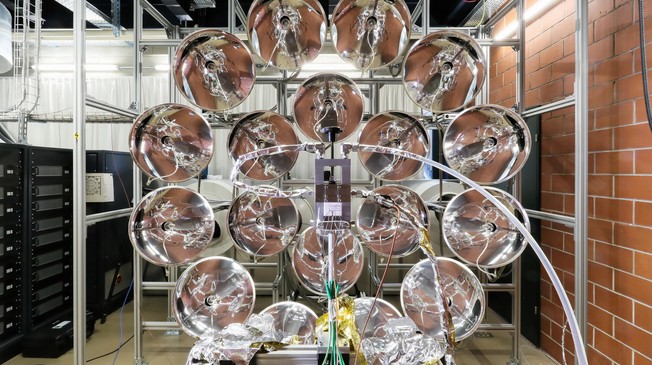Imagine what 18 giant light bulbs would do to your eyes. Now imagine that those lights were actually powerful enough to mimic the strength of several thousand times the sun’s radiation received on earth, with unparalleled power and precision.
Now stop imagining, because it’s now been developed by an EPFL laboratory and will be used to test various materials in extreme conditions.

The researchers have managed to replicate the heat and light of the sun’s radiation and now plans to use it to test solar power equipment and analyze materials in extreme temperature and heat conditions, to offer a full picture in just a few hours without the vagaries of the weather.
The system was developed in collaboration with the Australian National University and the company Kinoton Digital Solutions and is designed to produce the most intense light possible. The light can be adjusted precisely and does not create unnecessary heat since that could damage the materials being tested.
In order to create a light source with these capabilities, the team took 18 light sources and placed them in two concentric circles around a virtual half-sphere nearly two meters in diameter. Each of these lamps comprises of a reflector that is lit by a Xenon bulb. The light waves emitted in all directions by the bulb are reflected and focused on a specific point. At the spot where the light beams from the different lamps meet, the maximum intensity reaches 21,700 suns (21.7 MW m-2). This is the spot where materials and devices can be tested.
This system is so big that it takes up an entire room at the Laboratory of Renewable Energy Science and Engineering (LRESE). The research group led by Sophia Haussener is currently using it to develop new processes for converting and storing solar energy. For example, the researchers test heat transfer between various materials, which could improve the output from commercial concentrating solar power plants (the tower or cylindro-parabolic forms, both of which are in fast-growing use in the United States and Spain) or demonstrate the viability of new approaches to harnessing, transferring and converting light energy. Other collaborative efforts are also in the works, such as for characterizing space materials.
So, how did they make a system so powerful? The system’s performance was achieved mostly due to a new type of reflector, which is produced through electroforming.
“This is a method for the electrolytic deposition of metal, and it can replicate a model with unparalleled exactness,” said Gaël Levêque, a scientist at LRESE. “The precision of reflection is much better.”
There are more modules than in existing solar simulators and the current can be adjusted, which means the amount of power can be precisely controlled. The current provided to the lamps can be dialed anywhere from 70% to 120% of the 90 injected amps: this makes it possible to control the amount of luminous power delivered.
Over in Canberra, Australia, another team was building an identical system at the time EPFL was working on its system. However, the Australian version is also open-source, allowing the researchers to collaborate with their colleagues at the Australian National University and the company Kinoton Digital Solutions GmbH. As a result, other systems can be built on the basis of these calculations, using more or fewer lamps and different dimensions.
Learn more at EPFL.

Comments are closed, but trackbacks and pingbacks are open.